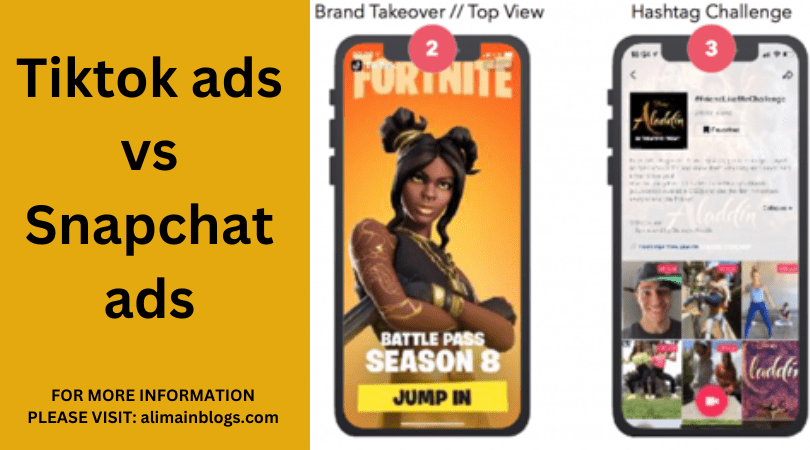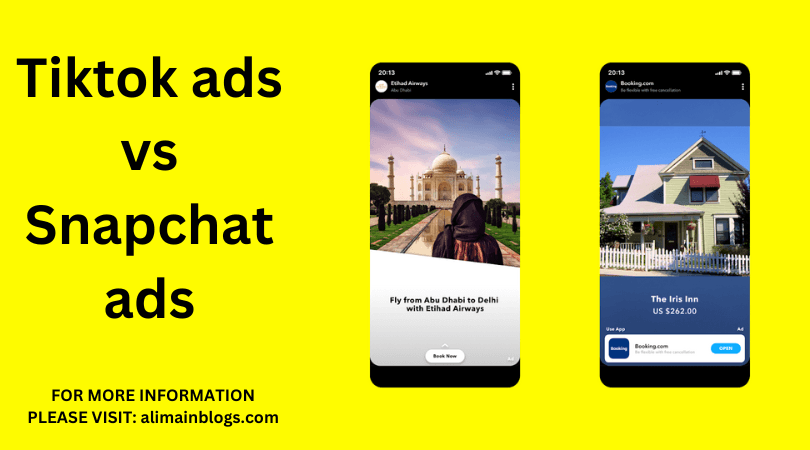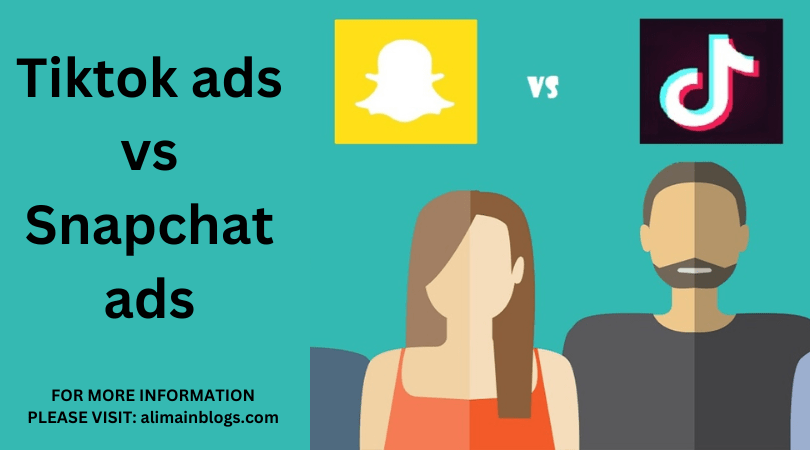TikTok ads

Tiktok ads vs Snapchat ads. The popular short-form video platform, offers various advertising options for businesses and advertisers to promote their products and services to a large and engaged user base. As of my last knowledge update in September 2021, TikTok’s advertising options included the following:
In-Feed Ads (formerly known as “Native Ads”):
These are short video ads that appear in users’ feeds as they scroll through the app. They typically last between 9 and 15 seconds and can include a clickable link to a landing page or app download.
Branded Hashtag Challenges:
Brands can create their own unique challenges and encourage users to participate by using a specific hashtag. These challenges often include a banner ad on TikTok’s Discover page to increase visibility.
Branded Effects:
Advertisers can create custom augmented reality (AR) effects and filters for users to use in their videos. This can help promote brand engagement and user-generated content.
TopView Ads:
These are short video ads that appear as the first thing users see when they open the TikTok app. They offer maximum visibility but are typically more expensive than other ad formats.
Branded Hashtag Plus:
This feature allows advertisers to combine their branded hashtag challenge with a shopping component, where users can click to shop for products related to the challenge.
TikTok Ads Manager:
TikTok provides a self-serve advertising platform where businesses can create, manage, and track their ad campaigns. It offers targeting options based on demographics, interests, and more.
Custom Audiences:
Advertisers can upload their customer lists to TikTok Ads Manager to create custom audiences for more precise targeting.
Lookalike Audiences:
TikTok allows advertisers to create lookalike audiences based on their existing customer lists to expand their reach to users with similar characteristics and behaviors.
Conversion Tracking:
TikTok offers conversion tracking tools to measure the effectiveness of ad campaigns and track actions such as app installs, website visits, and purchases.
Performance Analytics:
Advertisers can access detailed analytics and insights to monitor the performance of their ad campaigns and make data-driven optimizations.
Snapchat ads

Snapchat offers various advertising options to help businesses reach its user base, primarily consisting of younger audiences. As of my last knowledge update in September 2021, here are some of the types of Snapchat ads available:
Snap Ads:
These are full-screen video ads that appear between users’ Stories or in the Discover section. Snap Ads can include interactive elements, such as swiping up for more information, installing an app, or visiting a website.
Sponsored Lenses:
Sponsored Lenses are augmented reality (AR) filters or lenses that users can apply to their selfies. Businesses can create custom lenses with their branding or products, allowing users to engage with their brand in a fun and interactive way.
Sponsored Geofilters:
Geofilters are location-based overlays that users can add to their Snaps. Businesses can create custom Geofilters for specific locations or events, providing a subtle way to promote their brand.
Collection Ads:
Collection Ads allow businesses to showcase a series of products in a single ad. Users can tap on individual products to learn more or make a purchase.
Story Ads:
These are ads that appear in the Discover section of Snapchat and are similar in format to Publisher Stories. They provide a way for brands to tell a longer-form story to engage users.
Commercials:
Snapchat Commercials are non-skippable video ads that can appear in Snapchat Shows and Publisher Stories. They are designed to capture users’ attention with high-quality video content.
Snap Map Ads:
These ads appear on the Snap Map feature, allowing businesses to target users based on their location. Snap Map Ads can promote physical locations or events.
Dynamic Ads:
Dynamic Ads automatically create and update ad creatives based on a product catalog, making it easy for e-commerce businesses to reach their target audience with personalized content.
AR Try-On:
Businesses in the beauty, fashion, and eyewear industries can utilize AR Try-On ads to allow users to virtually try on their products through Snapchat’s AR technology.
Snapchat offers a range of targeting options, including demographic targeting, interest-based targeting, and custom audiences, to help businesses reach their desired audience effectively.
TikTok vs Snapchat – Audience Comparison

TikTok:
- Age Range: TikTok has a broad user base, but it’s particularly popular among teenagers and young adults. The primary age group is 16-24, but it also has users in their 30s and 40s.
- Demographics: TikTok’s user base is diverse in terms of demographics, but it tends to skew slightly more towards female users.
- Content: TikTok is known for short-form video content, with users creating and sharing 15 to 60-second videos. It’s a platform for creativity, entertainment, and trends, covering a wide range of topics from dance challenges to educational content.
- Engagement: Users on TikTok engage with content through likes, comments, shares, and by following accounts. The platform’s algorithm is known for its ability to surface content tailored to individual user interests.
Snapchat:
- Age Range: Snapchat’s user base skews slightly older than TikTok. It’s popular among teenagers and young adults, but it also has a substantial user base in their mid-20s to early 30s.
- Demographics: Snapchat’s user base is fairly evenly split between male and female users. It has a strong presence in North America and Europe.
- Content: Snapchat is known for its disappearing photo and video messages (Snaps) and Stories feature. It’s a platform for sharing real-time, ephemeral content, making it a more personal and private social media experience compared to TikTok.
- Engagement: Snapchat users engage by sending Snaps to friends, posting Stories, and using chat features. The platform is designed for more one-on-one or small group interactions, emphasizing privacy.

while both TikTok and Snapchat have a young user base, TikTok tends to attract a slightly younger audience, with a focus on short-form video content and a more algorithm-driven discovery system. Snapchat, on the other hand, caters to a slightly older audience and emphasizes personal, ephemeral communication through Snaps and Stories. The choice between the two platforms largely depends on the type of content you want to create or consume and your preferred style of social interaction.

Q: How do TikTok ads and Snapchat ads differ in terms of audience?
A: TikTok has a younger user base, with a significant portion of its users being teenagers and young adults. Snapchat also skews towards a younger demographic, but it has a slightly broader user base that includes some older age groups.
Q: What types of ad formats are available on TikTok and Snapchat?
A: Both TikTok and Snapchat offer a variety of ad formats. TikTok offers formats like in-feed ads, branded hashtags, branded effects, and more. Snapchat provides options such as Snap Ads, Story Ads, Filters, and Lenses.
How do the advertising costs compare between TikTok and Snapchat?
A: Advertising costs can vary greatly depending on factors such as targeting options, ad format, and campaign objectives. Generally, TikTok tends to be more expensive than Snapchat for advertising, especially for businesses targeting a global or broad audience.
Q: Which platform offers better targeting options?
A: Both TikTok and Snapchat offer robust targeting options, allowing advertisers to narrow down their audience based on factors like demographics, interests, and behaviors. TikTok has been expanding its advertising capabilities, making it increasingly competitive with Snapchat in terms of targeting options.
Q: What are some best practices for creating effective TikTok and Snapchat ads?
A: Best practices for creating effective ads on both platforms include understanding your target audience, creating engaging and authentic content, utilizing the unique features of each platform, and monitoring and optimizing your campaigns regularly.
=====================
FOR MORE INFORMATION PLEASE VISIT: alimainblogs.com
